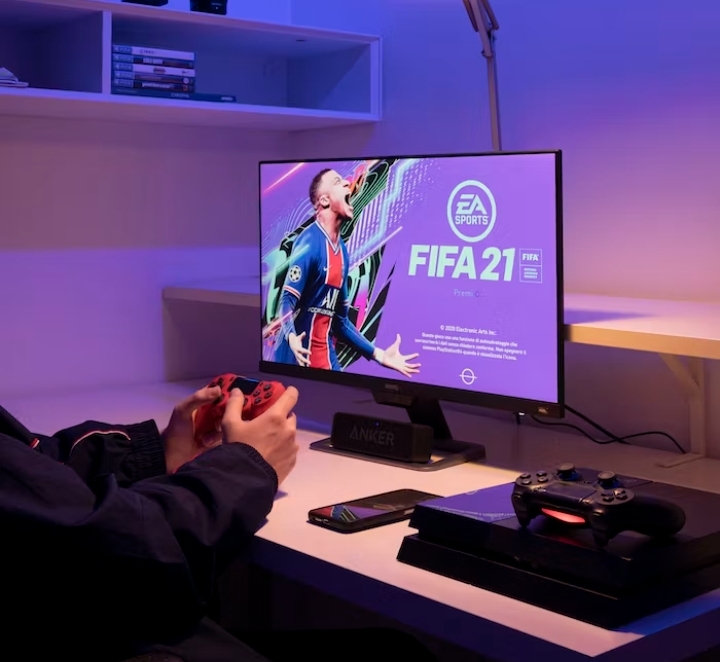What Is the Difference Between Mini LED and QLED?

Do you want to buy a new TV? Well, we’ve got you. Here’s how to pick between a Mini LED and a QLED screen display.
Buying a television is not as simple as it once was. As a result of changes in display technology, the modern television market is swamped with technical jargon. If you want to purchase a new television, you have a plethora of options on the market, ranging from QLEDs to Mini LEDs.
So, how do you choose between a Mini LED and a QLED display?
What is Mini LED?
Mini LED is a display technology that utilizes thousands of tiny LED lights to enhance the picture quality of an LCD (liquid crystal display) panel. Unlike traditional LED displays that use larger LEDs, Mini LED uses much smaller LEDs, allowing for more precise control over backlighting. This results in improved contrast, deeper blacks, and more vibrant colors.
How does Mini LED work?
In a Mini LED display, the backlight is made up of an array of thousands of tiny LEDs. These LEDs can be individually dimmed or turned off, providing greater control over local dimming zones. Local dimming allows specific areas of the screen to be darker while keeping other areas bright, resulting in better contrast and more accurate representation of colors.
Backlighting is provided by an array of blue Light Emitting Diodes (LEDs) in each LED TV. When a current is passed through these diodes, blue light is produced. However, blue light LEDs cannot be used for creating graphics on a screen. To address this issue, LEDs are coated with phosphorous. As a result, the LED array emits white light.
This light is then polarised by a polariser, which maintains a single phase of light vibrations. These vibrations are then transferred via a liquid crystal, which alters the wave direction. When the light waves’ direction changes, they pass through another set of polarisers before passing through a set of color filters that generate changing colors, allowing the television to provide vivid viewing experiences.
Advantages of Mini LED
Mini LED technology offers several advantages over traditional LED displays. Here are some key advantages of Mini LED:
Enhanced Contrast: Mini LED displays provide exceptional contrast ratios. The smaller size of Mini LEDs allows for more precise local dimming, resulting in deeper blacks and brighter whites. This leads to improved image quality and a more immersive viewing experience.
High Brightness: Mini LEDs can achieve higher brightness levels compared to standard LEDs. This makes them well-suited for outdoor displays, brightly lit environments, and HDR (High Dynamic Range) content, where a wide range of brightness levels is crucial for accurate reproduction.
Improved Color Accuracy: Mini LED displays can deliver a wider color gamut and more accurate color reproduction. With a larger number of smaller LEDs, the display can provide finer control over individual pixels, resulting in improved color accuracy and a more vibrant picture.
Reduced Halo and Blooming Effects: One of the drawbacks of traditional LED displays is the halo and blooming effect, where light spills over into neighboring pixels, causing a loss of detail and clarity. Mini LED technology minimizes this issue by employing a greater number of smaller LEDs, resulting in more precise localized lighting and significantly reducing halo and blooming effects.
Energy Efficiency: While Mini LED displays require more LEDs compared to standard LEDs, they are still more energy-efficient than other display technologies such as OLED. The improved local dimming capabilities of Mini LEDs allow for more efficient power management, reducing energy consumption while maintaining image quality.
Read Also: CAMM vs. SODIMM: What Is It and What’s the Difference?
What is QLED?
QLED, on the other hand, stands for Quantum Dot Light Emitting Diode. It is a display technology that utilizes quantum dots to enhance the color reproduction and overall picture quality of an LCD panel. QLED displays are known for their vibrant colors and excellent brightness levels.
How does QLED work?
As the name implies, television sets using QLED technology are very similar to LEDs.
The major difference between a QLED and an LED is that the QLED Makes use Quantum dots, and the Q in QLED stands for the same; but what are these Quantum dots? How can they improve LED technology? Let’s find out.
In a QLED display, quantum dots are used as a color filter to convert the backlight’s white light into specific colors. These quantum dots emit light of different wavelengths when excited by the backlight, creating a wider color spectrum. This enables QLED displays to reproduce more accurate and vivid colors compared to traditional LCD panels.
Instead of the phosphorus coating, a layer of Quantum dots is now placed in front of the blue LEDs in a QLED TV. The light from the blue LEDs hits the Quantum dots, exiting them and produces green and red light as a result of this setup. The light from the blue LEDs and Quantum dots then mixes to form white light, which is then transferred through the layers in the same manner as a standard LED.
This method of producing white light may appear contradictory given that a standard LED TV employs phosphorous coating to achieve identical results, but here’s the catch. When compared to phosphorus coatings, the white light produced by Quantum dots is brighter and has a better color composition.
Because of this advancement in backlighting, the colors reproduced by a QLED are crisper and have a higher peak brightness. Furthermore, the increased brightness enhances the contrast ratio of QLEDs when compared to LEDs.
Read Also: HDMI Splitter vs. HDMI Switch: What’s the Difference, and What Do You Need?
Differences between Mini LED and QLED
While both Mini LED and QLED offer significant improvements over traditional display technologies, there are some notable differences between them.
1. Display technology
Mini LED is primarily a backlighting technology that enhances the performance of LCD panels. It improves contrast and color accuracy by utilizing thousands of tiny LEDs for precise local dimming. On the other hand, QLED is a display technology that uses quantum dots as a color filter to enhance color reproduction and overall picture quality. It focuses on delivering vibrant and accurate colors.
2. Picture quality
Mini LED excels in providing deep blacks and bright whites, resulting in high contrast levels. The precise dimming control of individual LEDs minimizes backlight blooming and enhances the overall image quality. QLED, on the other hand, offers excellent color accuracy and a wider color gamut. It delivers more vibrant and true-to-life colors, making it a great choice for viewers who prioritize color reproduction.
3. Brightness and contrast
When it comes to brightness levels, QLED takes the lead. Its ability to achieve high brightness makes it suitable for well-lit environments and ensures better visibility in bright conditions. Mini LED displays also offer impressive brightness, but QLED displays generally have an edge in this aspect. In terms of contrast, Mini LED’s local dimming zones contribute to deeper blacks and brighter whites, resulting in superior contrast performance.
4. Energy efficiency
Energy efficiency is an important consideration for many users. In this regard, Mini LED has an advantage. The precise control over backlighting zones allows for efficient use of power, as LEDs can be dimmed or turned off when not required. QLED, while offering excellent picture quality, generally consumes more power due to the need for a bright backlight to enhance color reproduction.
LED vs QLED: Which one is better?
The choice between Mini LED and QLED ultimately depends on your priorities and preferences. If you value deep blacks, high contrast, and precise local dimming, Mini LED is a great option. Its best in enhancing image quality, particularly in dark scenes. On the other hand, if vibrant colors, excellent brightness, and wide color gamut are your priorities, QLED is the way to go. It delivers vivid and accurate colors that can make your viewing experience truly immersive.
When we look at these differences, we can see that Mini LEDs have higher contrast ratios, while QLED technology has higher color reproduction.
Read Also: HDR vs. SDR: What’s the Difference?
FAQs
Are Mini LED and QLED the same thing?
No, they are different technologies. Mini LED is a backlighting technology that enhances LCD panels, while QLED is a display technology that uses quantum dots to enhance color reproduction.
Which technology offers better contrast?
Mini LED technology offers better contrast due to its precise local dimming, which results in deeper blacks and brighter whites.
Do Mini LED and QLED displays consume more power?
QLED displays generally consume more power due to the need for a bright backlight, but Mini LED displays are more energy-efficient as they can dim or turn off individual LEDs when not required.
Can I get both Mini LED and QLED in a single display?
Yes, it is possible to have a display that combines both Mini LED and QLED technologies. Manufacturers have started incorporating these technologies together to leverage their respective advantages. This combination allows for enhanced contrast, vibrant colors, and improved overall picture quality.
Are Mini LED and QLED displays suitable for gaming?
Yes, both Mini LED and QLED displays are well-suited for gaming. They offer excellent picture quality, high contrast, and vibrant colors, providing an immersive gaming experience. The choice between the two depends on personal preferences and the specific features you prioritize for gaming.
Are Mini LED and QLED displays more expensive than traditional LCD displays?
Yes, Mini LED and QLED displays generally come at a higher price point compared to traditional LCD displays. The advanced technology and improved picture quality contribute to the increased cost.
Can I upgrade my existing TV to Mini LED or QLED?
It depends on the specific model and its compatibility with newer display technologies. While it may not be possible to upgrade your existing TV to Mini LED or QLED, you can consider purchasing a new TV or monitor that incorporates these technologies for an enhanced viewing experience.
Are Mini LED and QLED displays future-proof technologies?
Both Mini LED and QLED are considered to be future-proof technologies to a certain extent. They represent significant advancements in display technology and are likely to continue evolving and improving over time.







